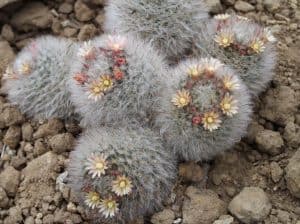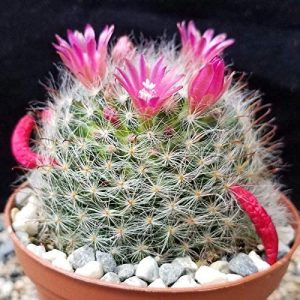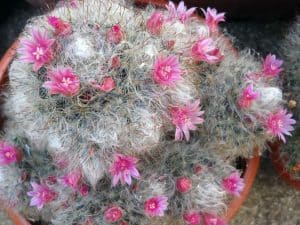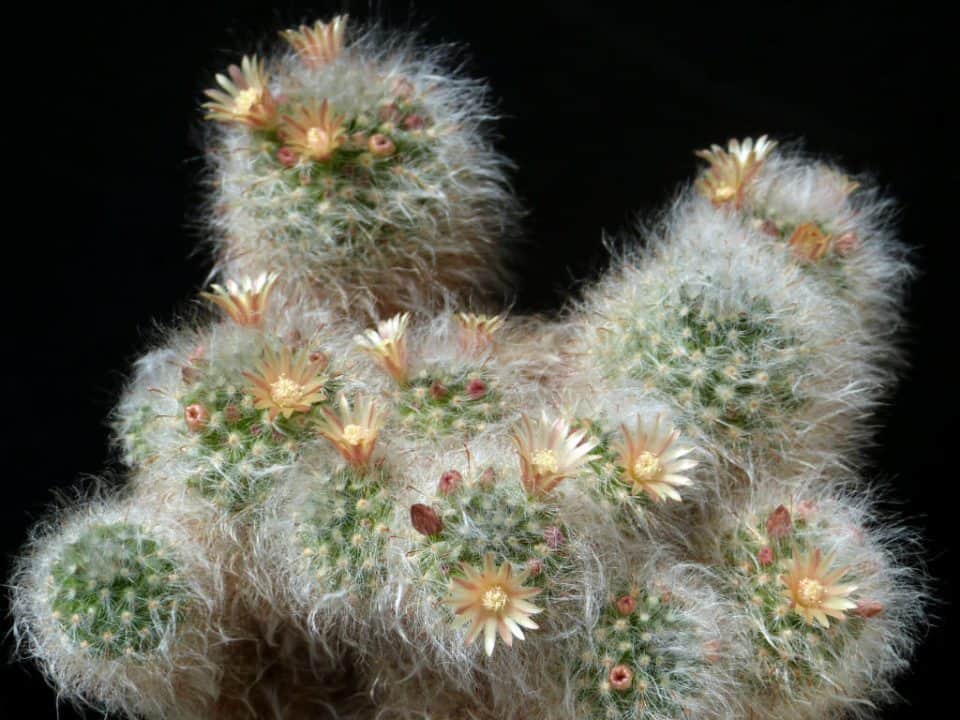A mammillaria bocasana, or powder puff cactus, looks almost exactly like the flower it’s named after. In fact, many people who see one of these unusual plants never realize it’s actually an incredible little plant in its own right!
The plant only grows to around six inches in height and the beautiful white, powdery fuzz makes it look like a small bouquet of flowers. A Mammillaria bocasana is generally fairly slow-growing and requires very little maintenance, making it one of the most desirable plants to have around the home or office.
Mammillaria bocasana can be an attractive addition to your desert garden, despite its less-than-desirable smell and appearance. This cactus’ unique name comes from its appearance, it looks like it’s covered in puffs of smoke or clouds, but that fluffy surface actually consists of fine hairs growing all over its body.
These hairs help keep moisture in during the plant’s dormant periods and make it easy to identify the species, but they don’t affect how you grow it or care for it otherwise.
Origin and distribution
Mammillaria bocasana is native to Mexico. It occurs in well-drained, rocky, or sandy soils from sea level to elevations of 1,500 m above sea level. It has been widely cultivated and naturalized in many areas outside its original range, including southern California and parts of Australia.
It has also been reported as a weed on disturbed sites in Hawaii. In their natural habitat, it grows under shrubs or small trees such as mesquite (Prosopis spp.) and palo verde (Parkinsonia spp).
Mammillaria bocasana is a winter-growing species of cactus which, along with its cousins Mammillaria plumosa and Mammillaria retusa (also called Coryphantha retusa), are commonly known as powder puff cactus.
As their name suggests, these cacti have wispy spines that stick out in all directions making them particularly well-suited to being grown as houseplants. To bring out their best, you should provide your powder puff with moderate temperatures and regular watering during their growing season.
This species is often confused with Mammillaria parviflora, but can be distinguished by its larger flowers and more powdery white spines. It flowers from spring through summer and produces fruit throughout most of that period. The fruits are spherical capsules about 3–4 mm in diameter that contain black seeds about 2 mm long.
This species was first described by John Lindley in 1841 based on specimens collected by William Balfour at Santa Rosa Island, off Baja California Sur, Mexico.
Mammillaria bocasana propagation

There are several methods of propagation, but you’ll usually see cacti grown from seed. The first step is to gather seeds from a mature plant, remove any debris and then soak them in a mix of water and hydrogen peroxide to eliminate any microbes that may be on them.
After they have soaked for 24 hours, rinse them well and then let them dry completely before sowing or planting.
In order to sow them, use a sterilized soil-less medium such as vermiculite or perlite and sow your seeds about 1/4 inch deep. Cover with another layer of medium so that it covers your seeds by about 1⁄4 inch and place in an area where there is bright light and no direct sunlight.
Mammillaria bocasana should germinate within 2 weeks. If you want to grow them from cuttings, take 4-inch sections of stem and remove all leaves except for one at the end. Dip these into rooting hormone powder and place them in a moistened growing medium.
Keep these moist until roots form which should take about 3 weeks. Once they have rooted, transplant them into larger pots using regular potting soil. Transplanting will cause some stress on your new plants, but it shouldn’t kill them if done correctly.
Water sparingly for about a month after transplanting to give their root systems time to establish themselves.
Once established, care for these plants just like any other succulent: provide lots of sun and water when needed but don’t overdo it!
Mammillaria bocasana care

For best mammillaria bocasana care, use a soil mix consisting of half cactus potting soil and half peat moss, both available at most nurseries. Be sure that your pot has drainage holes. In terms of watering, adjust so that the top inch or two of soil dries out between waterings; water more frequently in hot weather and less often during cold weather.
Light requirement
In its native environment, Mammillaria bocasana enjoys full sun exposure. When grown indoors, it will appreciate a southern or western-facing window that allows for approximately 6 hours of direct sunlight per day.
Make sure to rotate your cactus occasionally so that all sides receive equal amounts of light. Failure to provide enough light can result in an unhealthy and/or leggy plant with poorly formed flowers.
Also, keep in mind that Mammillaria bocasana is not frost-tolerant; if you live in an area where temperatures fall below 40 degrees Fahrenheit, you’ll need to bring your plant inside during the winter months.
Soil/potting mix
The soil in which you plant your cactus is extremely important. The ideal soil for a cactus must be well-draining with high air content. It should also have a neutral pH so as not to kill your plant or make it overly acidic.
A good potting mix consists of 40 percent peat moss, 40 percent sand, and 20 percent perlite or vermiculite, both of which are great at retaining water while allowing excess to drain through them.
If you’re looking to keep costs down, consider purchasing bags of topsoil from your local hardware store; however, keep in mind that these mixes may contain weed seeds and other contaminants that could harm your plants. Soil can also be purchased online or at specialty gardening stores.
Watering
With all of these succulents, it’s good to do an initial watering when you first get them. The amount of water needed after that depends on your soil and how much light it’s getting. With most cacti, over-watering is a bigger problem than underwatering, so err on side of less rather than more. To tell if they need water, give their leaves a little squeeze—if they’re not springy or flexible, then they need some watering.
When in doubt about how much water to give them, check out their soil with your finger—if it feels dry about halfway down, then it’s time for some more water. For example: If you can only push down 1/2 inch into moist potting mix before meeting resistance from dirt or roots, then it’s time for a bit of moisture!
Fertilizer
You should fertilize your mammillaria bocasana plant every two weeks during its growing season, spring through fall. Use a well-balanced fertilizer with at least 1/4 percent nitrogen, such as 10-10-10.
If you are using a slow-release fertilizer, split it into three applications: one early in spring, another early in summer, and a third in late summer. Avoid applying fertilizer when it’s hot outside; doing so can burn your cactus. Be sure to water your cactus after you fertilize it.
Temperature
Mammillaria bocasana is a very delicate cactus, which can survive in cold climates when not exposed to freezing temperatures. If you live in an area where temperatures fall below 32 degrees Fahrenheit, place your cacti outdoors during summer and bring them indoors before winter begins.
If you live in an area that has hot summers and cool winters, it’s best to keep your plants outdoors year-round. In areas with mild winters and hot summers, such as California or Florida, it’s fine to keep your plants outside all year long.
Humidity
Mammillaria bocasana cactus prefers humidity levels of 40-50% and should never be kept in full sun or direct sunlight, especially when they’re young. While they do fine in low light conditions, they will have a healthier appearance and grow faster if exposed to bright indirect light; sunburn is a common problem for Bocas and cultivars.
Pruning
Like any plant, Mammillaria bocasana requires regular pruning to stay healthy and productive. Prune your Mammillarias in late spring or early summer by cutting off unwanted flower stalks and dead, damaged, or diseased branches with scissors. If you want to control the size of your plant, to keep it from getting too big for its container, for example, prune away some of its oldest growth each year.
When to repot
Mammillaria bocasana should be repotted every 2-3 years. If your plant becomes rootbound and is no longer putting out new growth, it’s time to repot.
Another sign it’s time to put your plant in larger quarters is if you notice that its trunk has become balled up or damaged because of being confined to a small space. Repotting is also necessary when plants are moved from one location to another. As long as your cactus has healthy roots, it will recover quickly from transplanting.
Dormancy
Like most cacti, mammillaria bocasana undergoes a period of dormancy during which it doesn’t need much water, only enough to keep it from shriveling up completely.
In fact, overwatering is one of the biggest mistakes you can make when caring for a powder puff cactus. When watering it in spring or summer, be sure to use a potting mix with excellent drainage so that water can quickly drain away; otherwise, rot may set in.
Mammillaria bocasana flowers & fragrance

These plants have no special fragrance. However, they are attractive to hummingbirds and butterflies. Most plants have red flowers, which bloom in late spring or early summer.
Growth rate
Mammillarias are some of the fastest-growing cacti and can grow up to several inches in a single year if they have the proper care. If grown in a greenhouse, these cacti can even reach heights of 3 feet within their first year! Although it’s impossible to predict exactly how long it will take for your mammillaria to mature, remember that more time means more size!
Toxicity
Mammillaria bocasana is harmful if swallowed. Avoid contact with skin and eyes. Wash your hands thoroughly with soap and water after handling them. It will cause irritation of the skin and mucous membranes.
If swallowed, get medical help or contact a Poison Control Center right away. Symptoms may include burning, swelling, discoloration of the tongue or lips; difficulty swallowing, rapid breathing; hallucinations; blue fingers or toes; severe stomach pain, nausea, and vomiting.
USDA hardiness zones
Mammillaria bocasana thrives in USDA hardiness zones 8b through 11. In areas with cooler winters, you’ll want to plant your cactus indoors and then transplant it outdoors when the danger of frost has passed.
Pests and diseases
They are susceptible to various organisms that can infest, weaken and eventually kill them. Some pests to watch out for include mites, scale insects, aphids, thrips, and mealybugs. If your cactus is badly infested with any of these, you may want to consider removing it from its container so that you can wash it off well with water or mild soap.
After rinsing thoroughly, allow it to dry completely before repotting in fresh soil. Prune away any damaged sections and make sure that no insects remain on or near your plant before returning it to its container.
Conclusion
Powder puff cactus are also called porky plants or mammillaria bocasana. They’re a favorite among succulent collectors because of their colorful, patterned skin. Mammillarias prefer dry soil and little water, and they’re one of few succulents that can grow indoors in low light. They also stay compact, rarely growing over 6 inches tall.
